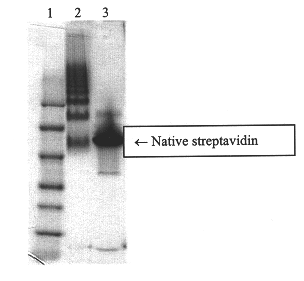Coated surfaces with high capacity for capturing target molecules
a technology of target molecules and coated surfaces, which is applied in the direction of biomass after-treatment, instruments, chemical indicators, etc., can solve the problems of low capacity of coated plates and surfaces to capture the intended target molecule, need to increase the capacity of such coated plates and surfaces, and reduce the sensitivity of assays, etc., to achieve enhanced sensitivity, high target molecule capture capacity, and extended linear working range
- Summary
- Abstract
- Description
- Claims
- Application Information
AI Technical Summary
Benefits of technology
Problems solved by technology
Method used
Image
Examples
example ii
10 mg of NeutrAvidin.TM. deglycosylated avidin dissolved at 10 mg / ml in PBS was derivatized with a 10M excess of SATA, dissolved at 40 mg / ml in DMF, for 1 hour. At the same time 10 mg of NeutrAvidin.TM. deglycosylated avidin dissolved at 10 mg / ml in PBS was derivatized with a 10M excess of Sulfo-SMCC, dissolved at 40 mg / ml in water, by reacting for 1 hour. The samples were purified using 10 mL crosslinked dextran desalting columns. The purified samples were combined in equal molor ratios. The combined volume was determined and then a quantity of 1M Hydroxylamine Hydrochloride, previously degassed under vaccuum, was added for the purpose stated in Example I so that the concentration of the Hydroxylamine Hydrochloride was 50 mM. The reaction was carried out for 1 hour and 30 minutes at room temperature under vacuum. As in Example I, the reaction was quenched with .beta.-mercaptoethanol for 15 minutes and the reaction capped with N-ethyl maleimide for 15 minutes. Then the sample was di...
example iii
This example illustrates the use of the plates prepared in Examples I, except white plates (96 well) were coated instead of clear plates. The illustrated assay compares, in a biotin phosphopeptide binding format, the effectiveness of the coated plates of the present invention to plates coated with the non polymerized protein. Coating of all plates was accomplished as described in the forgoing examples.
The coated plates (Example I and a plate coated with native streptavidin) were washed 2.times.200 .mu.l with PBS / 0.05% Tween.TM. 20 detergent. Tyrosine Kinase Peptide 2 (Pierce Chemical Company), biotinylated and phosphorylated was diluted using PBS / 0.05% Tween.TM. 20 detergent. The dilution of the biotinylated phosphopeptide was made so that when 100 .mu.L was added to the well, the range covered 0 to 15 pM / well. 100 .mu.L of each dilution was added to Rows 1-12. The plates were incubated for 1 hour at room temperature. The plates were then washed 3.times.200 .mu.l with PBS / 0.05% Twee...
example iv
This example illustrates the use of the plates prepared in Examples I, except white plates (96 well) were coated instead of clear plates. The illustrated assay compares, in a biotinylated oligonucleotide binding format, the effectiveness of the coated plates of the present invention (Example I) to plates coated with the non polymerized streptavidin. Coating of the plates was accomplished as described in the forgoing examples.
The coated plates were washed 2.times.200.quadrature.l with PBS / 0.05% Tween.TM. 20 detergent. Biotinactincapture oligonucleotide was made up in PBS at a concentration of 1.25.quadrature.M. The diluted biotinylated oligonucleotide was added at 100.quadrature.L per well in Row 1 of the plates. A 1:1 serial dilution was made, using 100.quadrature.L PBS and 100.quadrature.L of the 1.25.quadrature.M biotinylated oligonucleotide in PBS from Row 2 to 11. Only PBS was added to the Row 12 wells of each plate. The plates were incubated for 1 hour at room temperature. The ...
PUM
| Property | Measurement | Unit |
|---|---|---|
| molecular weight | aaaaa | aaaaa |
| molar ratio | aaaaa | aaaaa |
| molar ratio | aaaaa | aaaaa |
Abstract
Description
Claims
Application Information
 Login to View More
Login to View More - R&D
- Intellectual Property
- Life Sciences
- Materials
- Tech Scout
- Unparalleled Data Quality
- Higher Quality Content
- 60% Fewer Hallucinations
Browse by: Latest US Patents, China's latest patents, Technical Efficacy Thesaurus, Application Domain, Technology Topic, Popular Technical Reports.
© 2025 PatSnap. All rights reserved.Legal|Privacy policy|Modern Slavery Act Transparency Statement|Sitemap|About US| Contact US: help@patsnap.com

